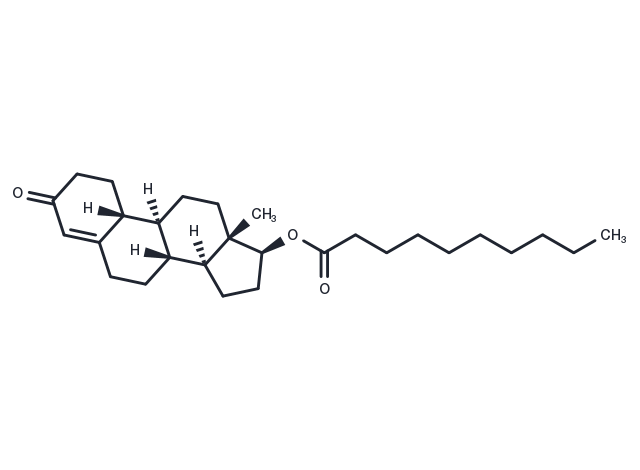Powder: -20°C for 3 years | In solvent: -80°C for 1 year


Nandrolone decanoate (19-Nortestosterone decanoate) is the decanoate salt form of nandrolone, an anabolic steroid analog of testosterone with androgenic, anabolic, and erythropoietin stimulating effects. Nandrolone enters the cell and binds to and activates specific nuclear androgen receptors in responsive tissue, including the prostate, seminal vesicles, scrotum, penis, larynx, hair follicles, muscle, and bone.

| Pack Size | Availability | Price/USD | Quantity |
|---|---|---|---|
| 25 mg | In stock | $ 38.00 | |
| 50 mg | In stock | $ 50.00 | |
| 100 mg | In stock | $ 72.00 | |
| 200 mg | In stock | $ 131.00 | |
| 500 mg | In stock | $ 222.00 | |
| 1 mL * 10 mM (in DMSO) | In stock | $ 45.00 |



| Description | Nandrolone decanoate (19-Nortestosterone decanoate) is the decanoate salt form of nandrolone, an anabolic steroid analog of testosterone with androgenic, anabolic, and erythropoietin stimulating effects. Nandrolone enters the cell and binds to and activates specific nuclear androgen receptors in responsive tissue, including the prostate, seminal vesicles, scrotum, penis, larynx, hair follicles, muscle, and bone. |
| In vitro | The anabolic steroid nandrolone decanoate with the used concentrations, is not able to change the viability of muscle cells during the in vitro differentiation process[2]. |
| In vivo | High nandrolone decanoate doses lead to decreased serum glucose, accompanied by high serum insulin levels during fasting. Glucose production rate and liver glycogen content are decreased by the chronic administration of nandrolone decanoate, probably resulting in decreased fasting glucose[1]. In vivo studies demonstrate that the effects of nandrolone decanoate depended on the assessed muscles, time of treatment, dose and association or not with exercises. All of these are able to cause increased muscle mass, alterations in the cell cycle, bone mineral density, bone growth, and the ARs influence these effects[2]. |
| Kinase Assay | Affinity assay: The affinity of Aclidinium for the different human muscarinic receptor subtypes at equilibrium is determined by measuring their ability to displace the binding of [3H]NMS to cell membrane preparations expressing one of the human muscarinic receptor subtypes. Protein concentrations are 8.1 μg/well, 10.0 μg/well, 4.9 μg/well, 4.5 μg/well, and 5.0 μg/well for M1, M2, M3, M4, and M5 receptor membrane preparations, respectively. The assays are conducted at [3H]NMS concentrations approximately equal to the radioligand equilibrium dissociation constant (Kd) for the different muscarinic receptors subtypes. The [3H]NMS concentration is 0.3 nM for the M1 and M4 assays and 1 nM for the M2, M3, and M5 assays. A range of antagonist concentrations (10?14 to 10?5 M) are tested in duplicate to generate competition curves. Nonspecific binding is determined in the presence of atropine (1 μM). Assay reagents are dissolved in assay binding buffer (phosphate-buffered saline with calcium and magnesium) to a total volume of 200 μL. After a 2 hours or 6 hours incubation period (M1–M4 and M5, respectively) at room temperature in 96-well microtiter plates to ensure that equilibrium is achieved for Aclidinium, 150 μL aliquots of the reaction are transferred to GF/C filter plates pretreated for 1 hour with wash buffer (50 mM Tris, 100 mM NaCl, pH 7.4) containing 0.05% polyethylenimine. Bound and free [3H]NMS are then separated by rapid vacuum filtration followed by four washes with ice-cold wash buffer. Filters are then dried for 30 min before addition of 30 μL of OptiPhase Supermix, and radioactivity is quantified using a MicroBeta Trilux microplate scintillation counter. |
| Cell Research | Cell viability is assessed one, three and five days after incubation with nandrolone decanoate at the final concentrations of 5, 10, 25 and 50 µM or the drug vehicle (1.5:1-benzyl alcohol/peanut oil), added in different amounts according to the anabolic concentrations (vehicle 5, 10, 25 and 50 µM, respectively). Together with the treatment with the anabolic steroids, 2% horse serum was added to the culture for the induction of differentiation of muscle cells. (Only for Reference) |
| Synonyms | 19-Nortestosterone decanoate |
| Molecular Weight | 428.65 |
| Formula | C28H44O3 |
| CAS No. | 360-70-3 |
Powder: -20°C for 3 years | In solvent: -80°C for 1 year
DMSO: 4.29 mg/mL (10 mM)
You can also refer to dose conversion for different animals. More
bottom
Please see Inhibitor Handling Instructions for more frequently ask questions. Topics include: how to prepare stock solutions, how to store products, and cautions on cell-based assays & animal experiments, etc.
Nandrolone decanoate 360-70-3 Microbiology/Virology Others Proteases/Proteasome HIV Protease inhibit NMDAr HIV Human immunodeficiency virus behavior Inhibitor glutamate 19-Nortestosterone decanoate aggressive Androgen Receptor GLT-1 memantine transporter inhibitor
